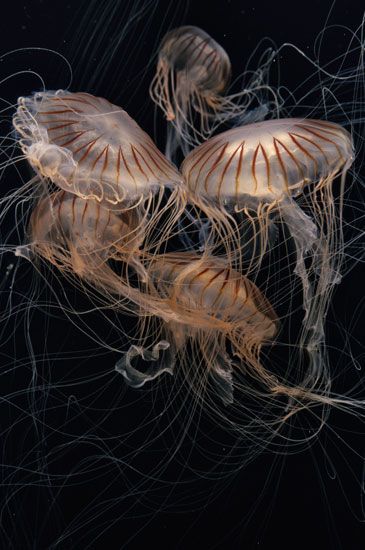14 Fun Facts About Jellyfish
Number 8: One species may be immortal. It can play its lifecycle in reverse, transforming from an adult medusa back to an immature polyp
/https://tf-cmsv2-smithsonianmag-media.s3.amazonaws.com/filer/20120417092051JelliesExperience-web.jpg)
At the Monterey Bay Aquarium, jellyfish are a fan favorite—as long as the stinging swimmers are behind glass. Something about the even pulsing of the delicate, bell-shaped creatures has a calming effect on visitors. Some even say their heart rates slow when watching the jellies.
It is this trance-inducing quality that helped inspire the aquarium’s new 1960s-themed, Jimi Hendrix-esque exhibition: “The Jellies Experience.” The show, open through September 2014, is the latest chapter in the aquarium’s history of cultivating and exhibiting jellyfish. In 1985, the Monterey facility became a pioneer in jellyfish display when it exhibited moon jellies for the first time. Seven years later, the aquarium staged “Planet of the Jellies,” its first all-jellies exhibition. A permanent jellies gallery opened in 1996, as part of the Open Sea wing, and in 2002, the aquarium hosted “Jellies: Living Art,” another temporary show. But “The Jellies Experience,” says Raúl Nava, an exhibit developer and writer at the aquarium, is by far the most interactive.
Nava recently gave me a tour. We walked through the exhibit’s six rooms, each centered on a different aspect of jellyfish—their movement, body structure, stinging capabilities, diversity, possible population booms and bioluminescence. Hands-on elements along the way give a sense of what it is like to be a jelly. Press down on one of three waist-high columns in one room, for instance, and you can control the image of a jelly pulsing across a screen. Stand in front of a camera mounted in the wall in another gallery and see a kaleidoscopic image of yourself that mimics a jellyfish’s radial symmetry. Draw a digital jellyfish on a touch screen and free it into a virtual ocean, along with other visitors’ creations. And walk through a mirrored room with three cylindrical tanks of live jellies to experience the illusion of being in a swarm of jellyfish.
The interactive features, however, do not outshine the 16 species of live jellies displayed. Exhibit designer Koen Liem came up with the show’s psychedelic vibe, but as he says, ”the animals are the real stars.” From Japanese sea nettles to upside-down jellies, flower hat jellies to cross jellies and blubber jellies, the creatures, some raised at the aquarium and others collected, are mesmerizing. I found myself studying them and their intricate details—crimped tentacles, fluorescent colors, stripes and spots.

Here are 14 fun facts about jellies:
1) A group of fish is called a school. A gathering of dolphins is a pod. Several otters makes up a romp. And an assemblage of jellies is a swarm or, better yet, a smack.
2) “Swarm” and “bloom” should not be used interchangeably when talking about jellies. A swarm refers to jellies that collect in one area as a result of strong winds or currents, whereas a bloom is a dense cloud of jellies caused by an actual spike in reproduction.
3) Jellies are 95 percent water.
4) Musician Frank Zappa is the namesake of one species of jelly, Phialella zappai. (For an explanation, see Smithsonian writer Abigail Tucker’s story, “Extreme Jellyfish.”)
5) Though jellies are soft-bodied and lack a skeleton, making fossils rare, there is evidence that jellyfish predate dinosaurs by some 400 million years.
6) A historic moment for jellyfish came in May 1991, when 2,478 moon jelly polyps and babies were launched into space aboard the shuttle Columbia. Biologist Dorothy Spangenberg of the Eastern Virginia Medical School wanted to learn about how weightlessness affected the development of juvenile jellies. She monitored calcium loss in the jellies, which by extension could further scientists’ understanding of humans’ calcium loss in space.
7) Some jellyfish, such as blubber jellies, a delicacy in parts of Asia, are edible. A former colleague wrote about her culinary adventure tasting jellyfish in Washington D.C.’s Chinatown.
8) Most jellyfish live anywhere from a few hours to a few months. But a species of jelly called Turritopsis nutricula may be immortal. The jelly reportedly can play its lifecycle in reverse, transforming from an adult medusa back to an immature polyp.
9) Jellies have been known to eat other jellies.
10) The creatures lack not only bones, but heads, hearts and brains.
11) Researchers from the Monterey Bay Aquarium Research Institute surmise that cross jellies (Mitrocoma cellularia), common to Monterey Bay in the spring and summer, can “smell” prey through chemicals in the water.
12) A recent study found that four of the box jellyfish Tripedalia cystophora‘s 24 eyes always point up. The jellyfish looks through the water surface for tree branches. This way, it can swim towards mangrove swamps where it feeds.
13) GFP, a green fluorescent protein found in crystal jellies, has important medical applications. Mayo Clinic scientists recently inserted a version of GFP and a gene from a rhesus macaque known to block a virus that causes feline AIDS into a cat’s unfertilized eggs. When the kittens were born, they glowed green in ultraviolet light, indicating that the gene was successfully transferred. Biologist Osamu Shimomura won a Nobel Prize in Chemistry in 2008 for discovering GFP.
14) Jellyfish can sting even when they are dead. In 2010, about 150 swimmers at Wallis Sands State Park in New Hampshire were stung by the floating, 40-pound carcass of a lion’s mane jellyfish.
/https://tf-cmsv2-smithsonianmag-media.s3.amazonaws.com/accounts/headshot/megan.png)
/https://tf-cmsv2-smithsonianmag-media.s3.amazonaws.com/accounts/headshot/megan.png)